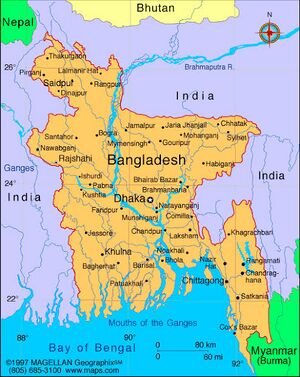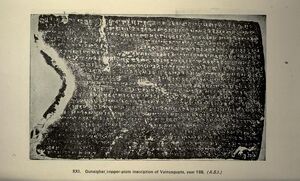Gunaighar


Gunaighar (Gunāighar) village belongs to the large pargana Bardakhat (formerly Baldakhal) in Comilla district (18 miles to the north-west of Comilla) in Bangladesh. It is one of the twelve villages of the pargana with their names ending in "-ghar" (cf. the popular phrase in Bengali current in the pargana--"Bara ghar ek dwar"). It is well-known in the district as full of antiquities. Coordinates:Lat 23° 36' 0N, Long 90° 58' 0E, Altitude (meters) 2, Time zone (est)
A fine image of Visnu in black stone was discovered many years ago in the village and is still worshipped there. A stone image of the Buddhist God Avalokitesvara with twelve hands was also discovered in the village, with the formula "ye dharmma &c. inscribed in the pedestal. Only recently another stone image of Visnu has been unearthed. Ruins of a temple of Visnu exist in the village and a small mound popularly known as Chudar Par is supposed to cover the ruins of another temple. The place is likely to yield more important finds if properly investigated. A temple of Pradyumnesvara is mentioned in the plate giving a far greater antiquity to the worship of a form of Siva, immortalised by the poet Umapatidhara in the Deopara prasasti of Vijaya sena.
Gunaighar Copper-plate Inscription of Vainyagupta Gupta Year 188 (=A. D. 507)
- (Lines 1-2) Hail! From the victorious camp full of great ships and elephants and horses(1) (situated) at Kripura, the glorious Maharaja Vainyagupta,(2) who meditates on the feet of God Mahadeva, being in good health, issues a command after wishing health to ......, and his own dependents: Be it known to you that
- (Lines 3-8) For enhancing the religious merits of myself and my parents, on the request of Maharaja Rudradatta, a slave to our feet, in the village of Kantedadaka (कांतेड़दक ग्राम) situated in the "Northern Mandala", eleven Patakas of uncultivated lands in five plots are granted by Me, by means of a copper plate as an Agrahara in absolute possession; for providing perpetually for perfumes, flowers, lights, incense, etc. thrice a day unto the Lord Buddha in the abode of the Vaivarttika congregation of monks (belonging) to the Mahayana, established by the Buddhist monk of the Mahayana, Acaryya Santideva, in the Asrama-'Vihara (dedicated) to Arya-Ava-lokitesvara, which (Vihara) was being constructed in the part of.... by that (king) for the sake of that Acaryya; and for the enjoyment of garments, food, beds, seats, medicines for the sick etc. by that congregation; and also for repairing breaks and cracks in the Vihara.
- (Lines 8-11) Here again, both veda and smrti (texts) are indeed prescribed.(3) By Reading in the legal text, enjoining special merits both here and hereafter, the sense of
- 1. The opening expression mahanau etc. occurs in the Gaya plate of Samudragupta (Gupta Ins., p.256) and also in the Banskhera and Madhuban plates of Harsha.
- 2. Vainya, a spnonym for "the first king" Prthu, is spelt here with the dental nasal as in Rgveda, VIlI. ix, Io. It is now generally spelt with the cerebral (cf.Gupta, Ins., p. 74-- abhijati-gunenavainyam).
- 3. Apa-vihita is a rare word not found elsewhere.
- a (now lost) Vedic text regarding holy gift of lands,(1) and themselves courting even hardships, enemy kings, who (are agreeable to giving) lands to proper persons, should, upon our honour in words and also for themselves acquiring fame) and merits, approve (the grant of) these Patakas unto this Vihara.
- (Lines 11-14) Regarding keeping up (in future), there are again verses sung by the revered Vyasa, the compiler of the Vedas, and the son of Parasara:--
- (v.1) The giver of land rejoices in Heaven for sixty thousand years and he who confiscates and he who assents live in Hell for that period.
- (v.2) He who takes away land given by himself or by others rots along with his forefathers becoming a worm in soil.
- (v.3) O Yudhishthira, the best of kings, protect carefully the land granted by former (kings) to Brahmins, for, protection is better than the gift itself.
- (Lines 14-18) In the current year of One Hundred and Eighty-Eight, on the 24th day of the month of Pausa, by the Royal Ambassador, the great Frontier King Maharaja Vijayasena, who is the High Chamberlain, the Officer-in- charge of Elephants, the President of the Board of Five Law Court Officers and President of City Governors, the (royal) command for the gift of these eleven Patakas is made known unto the Kumaramatyas Revajjasvami, Bhamaha and Vatsa-bhojika. (This is) written by Karana-Kayastha Naradatta, who is the Minister in charge of Peace and War.
- (Lines 18-27) Wherein the first plot of land measuring seven Patakas and nine Dronavapas, the boundary marks are, to the East, the border of the Gunikagrahara village and the field of Engineer Visnu; to the South, the field of Miduvilala(?) (मिदुविलाल-क्षेत्र) and the field belonging to the Royal Vihara; to the West, the Surinasirampurnneka(?) (सूरीनाशीरमपूर्ण्णेक-क्षेत्र) field; to the North, the tank of Dosibhoga,...and the boundaries of the fields of(?) Vampiyaka and Adityabandhu. Of the second plot measur-
- 1. Reading Smrtam makes much the same sense.
- ing tmenty-eight.Dronavapas, the boundaries are, to the East, border of Gunikagrahara village; to the South, the field of Pakkavilala(?); to the West, the field of the Royal Vihara. To the North, the field of Vaidya...... Of the third plot measuring twenty-three Dronavapas the boundaries are to the East, the field of......; to the South, the boundary limit of the field of........; to the West, the field of Jolari (जोलारी-क्षेत्र); to the North, the field of Nagi jodaka (नागी-जोडाक-क्षेत्र). Of the fourth plot of land measuriug thirty Dronavapas, the boundaries are, to the East, the boundary limit of the field of Buddhaka (बुद्धाक-क्षेत्र); to the South, the field of Kalaka (कालाक-क्षेत्र); to the West, the boundary limit of the field of Suryya(सूर्य्य-क्षेत्र); to the North, the field of Mahipala (महिपाल-क्षेत्र) Of the fifth plot of land measuring a couple of Patakas less a quarter, the boundaries are, to the East, the field of Khandaviduggurika (खंडविडुग्गुरिक क्षेत्र); to the South, the field of Manibhadra (मणिभद्र-क्षेत्र); to the West, the boundary limit of the field of Yajnarata; to the North, the boundary limit of the village Nadadadaka (नादड़दक ग्राम).
- (Lines 27-31) The boundary marks of the low lands(1) belonging to the Vihara are, to the East, the channel between the (two) ports of ships at Cudamani and Nagarasri(2); to the South, the channel, open to ships connnected to the large marshy pond of Ganesvara(3); to the West, the end of the field belonging to the temple of Pradyumnesvara; to the North, the channel (leading) to the port of Pradamara.(4) The boundary marks also of water-logged waste lands pertaining to the right of entrance(5) of this Vihara and paying no
- 1. For talabhumi cf. tala-pataka in the Khalimpur grant 1.52.
- 2. There are possibly two place names here: it may also mean "at the town of Cudamani," the epithet Sri is then ill construed with nauyoga.
- 3. Can it be a place name?
- 4. Also seems to be a place name rather than that of a person.
- 5. The word pravesya is difficult to interpret. The meaning suggested by Dr. Sukthankar, following Hultzsch, "that which belongs to the pravesa" (a territorial division), Ep. Ind., XVII, p.106 does
- requital (tax)' are to the East, the boundary limit of the field belonging to the temple of Pradyumnesvara; to the South, the limit of the field belonging to the Vihara of the Buddhist monk, Acaryya Jitasena; to the West, the stream(2) Hacata; to the North, the tank of Danda(?).
- (Line 31) The year 188, the 24th day of Pausa.
- 1. Pratikara can hardly mean 'the right of alienation'; it may simply mean 'tax' (kara) or better'a state allowance.'
- 2. Gamga 'a stream' survives in the word gang still current in East Bengal (cf. Dr. S.K. Chatterji :loc. cit. pp.305 and 363).
External links
Note - Tej Ram Sharma has explained terms appearing in this inscription in his book available here - Personal and geographical names in the Gupta inscriptions, pp 249-252.

